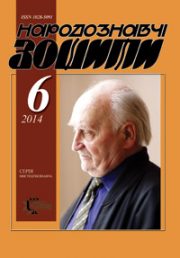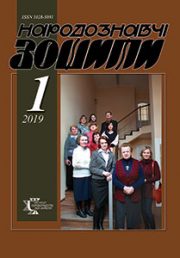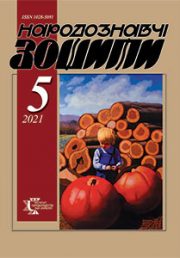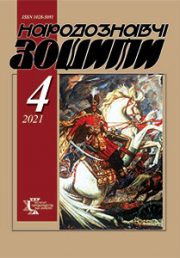The Ethnology Notebooks. 2020. # 6 (156), 1303—1313
УДК 94(=512.19:560)”1980/2000″
DOI https://doi.org/10.15407/nz2020.06.1303
Rustem ABLÂTİF
- Master in Public Administration, PhD candidate
- Ivan Franko National University of Lviv
- Department of Middle Ages and Byzantine Studies
- 1, Universitetska Street, 79000, Lviv, Ukraine,
- email: abu-bakr@ukr.net
Introduction. The Crimean diaspora in Turkey was gradually formed over almost two centuries, from the annexation of the Crimean Khanate by the Russian Empire in 1783 to the last wave of an emigration in the late 1940s.
Problem statement. The issue of development activities, in particular cultural and publishing ones, of the Qırımlı assosiations in Turkey since the 1980s, from the beginning of the repatriation process the Qırımlı nation from the former places of the exile to their historical Homeland — Crimea until the beginning of the 2000s, when the mass repatriation of the Qırımlı to the Ukraine’s territory practically stopped, as well as an impact of this process on the Crimean diaspora’s activities, are researched and analyzed. An attention is focused to the diasporic periodicals in Turkey, the reasons and circumstances of its appearance and development in the investigated period are also analyzed. The role of the media and book publishing in Turkey to provide the informational support for the Qırımlı people’s repatriation process to Crimea is emphasized. An attention was also paid to the cultural and educative activities of the Turkish communities of Qırımlı as a factor to preserve their identity and ethnic self-identification.
Purpose. The objective of this work is to study activities of the organizations of the Crimean diaspora of Turkey, directed to support the Qırımlı nation’s repatriation process, in particular the forms and methods of providing such support.
Methods. The work uses latest advances in the oral history. Specially conducted interviews with activists of Crimean societies became one of the principal sources of information on the non-governmental organizations’ activities in Turkey. As an archival information was used the minute books of the societies of Ankara, Eskişehir and İstanbul that are legal documents and are subject to storage.
Results. Areas of the Crimean societies’ activity are identified: a development of culture and folklore, a development of their own periodicals to inform the Turkish society about the problems of the Qırımlı nation, an assistance for the Qırımlı’s repatriation to their historical Homeland, to render material and moral support, etc.
Conclusion. Activities of the Qırımlı societies in Turkey, in particular cultural and publishing ones, in the late 1980s — early 2000s, were characterized by a considerable intensification and change of their activities’ priorities that is caused above all by the process of the Qırımlı nation’s mass repatriation from former exile places to their historical Homeland — Crimea. The Crimean societies were trying to render a support for this repatriation process and their struggle for civil rights at that time.
Keywords: Qırımlı diaspora, periodical, book publishing, culture, lobby work, Crimea, Turkey.
REFERENCES
- Karpat, K.H. (1985). Ottoman Population 1830—1914. Demographic and Social Characteristics (P. 244). Madison; Wisconsin.
- Kırım Turkleri Kultur ve Yardımlaşma Dernegi Istanbul Subesi: official page. Retrieved from: http://istanbulkirim.org/hakkimizda/tarihce/ (Last accessed: 04.04.19) [in Turkish].
- Kırım Turkleri Kultur ve Yardımlasma Dernegi Istanbul Subesi: oficial cite. Retrieved from: http://istanbulkirim.org/hakkimizda/tuzuk/ (Last accessed: 04.04.19) [in Turkish].
- Ahmed Ihsan Kırımlı. Retrieved from: https://uk.wikipedia.org/wiki/%D0%90%D1%85%D0%BC%D0%B5 %D0%B4_%D0%86%D1%85%D1%81%D0%B0%D0%BD_ %D0%9A%D0%B8%D1%80% D0%B8%D0%BC%D0%BB%D0%B8 (Last accessed: 02.02.19) [in Ukrainian].
- Kulchytskyi, S. (2018). Struggle of the Crimean Tatars for return to the Motherland. Ukrajinskyi istorychnyi zhurnal, 2, 75—109 [in Ukrainian].
- Yakup Satar. URL: https://tr.wikipedia.org/wiki/Yakup_Satar (Last accessed: 06.04.2019) [in Turkish].
- Aydın, F.T. (2012). Comparative Cases in Long-Distance Nationalism: Explaining Emirgre, Exile, Diaspora and Transnational Movements of the Crimean Tatars. (Thesis for a Doctor of Philosophy in Political Science). University of Toronto. Retrieved from: https://tspace.library.utoronto.ca/bitstream/1807/67253/1/ Aydin_Filiz_T_201211_PhD_thesis.pdf (Last accessed: 21.11.2018).
- Teprec. Retrieved from: https://crh.wikipedia.org/wiki/Tepre% C3%A7 (Last accessed: 07.04.19) [in Crimean Tatar].
- (1997). Dernegimizin geleneksel 9. Teprec senlikleri 15 Haziran 1997’de kutlandı. Kalgay, 4—6, 13—14 [in Turkish].
- (1989). Polatlı‘da Kırım Gecesi. Emel, 172, 61 [in Turkish].
- (1998). Geleneksel ciborek gecesi. Kırım Postası, 2, 15 [in Turkish].
- (1991). Konya’da Kırım gecesi. Emel, 184, 60 [in Turkish].
- (1995). Istanbul’da Kırım gecesi. Emel, 208, 43 [in Turkish].
- (1989). Konya’da Kırım gecesi. Emel, 174, 47 [in Turkish].
- (1987). Kırım Turk halk oyunları ekibi televizyonda Limana oyununu sergilendiler. Emel, 159, 46 [in Turkish].
- (1999). Kırım Tatar Milli Tiyarosu. Turkiye Turnesi. Kırım Bulten, 27—35, 3 [in Turkish].
- Kemal Çapraz. Retrieved from: https://tr.wikipedia.org/wiki/Kemal_%C3%87apraz (Last accessed: 11.04.19) [in Turkish].
- (1990). «Kırım Tatar Turkleridne basın» konulu tez hazırlandı. Emel, 181, 46 [in Turkish].
- Kemal Capraz. Retrieved from: http://www.biyografi.net/kisiayrinti.asp?kisiid=3098 (Last accessed: 11.04.19) [in Turkish].
- Ozcan, K. Surgundeki Kırım Tatarları hakkında Ukrayna arsivlerinde yer alan (1954—1967 doneminde ait) bazı belgeler ve degerlendirmeleri. Retrieved from: https://dergipark.org.tr/tr/download/article-file/102066 (Last accessed: 11.04.19) [in Turkish].
- (1989). Kırım sehitleri için İstanbul’da Mevlüd okutuldu. Bursa’da Mevlud ve iftar yemegi. Emel, 172, 62 [in Turkish].
- (2000). Surugunun 56. Yılı ve mucadelemiz. Bahcesaray, 10b, 1—3 [in Turkish].
- (1998). Kırım’da Kurban kesimi. Kırım Postası, 1, 13 [in Turkish].
- (1992). MUSAN’in «Turk cumhuriyetleri ve Kırım Turkleri» konulu paneli. Emel, 189, 36 [in Turkish].
- (1994). Haberler. Bahcesaray, 2, 4 [in Turkish].
- Bektore, Y. (1998). Turkiye’de Kırım ve Tatar imajı. Kırım Postası, 2, 1—3 [in Turkish].
- (1998). Kardes okul mudurleriyle toplantı. Kırım Postası, 3, 14—15 [in Turkish].
- Karatay, Z. (1991). Kırım Turklerinin II. Milli Kurultayı. Emel, 28, 28—36 [in Turkish].
- Mustecib Ulkusal. Retrieved from: https://crh.wikipedia.org/wiki/M%C3%BCstecib_%C3%9Clk%C3%BCsal (Last accessed: 15.04.2019) [in Crimean Tatar].
- Emel Turk Kulturunu Arastırma ve Tanıtma Vakfı: official page. Retrieved from: http://emelvakfi.org/emel-kirim-vakfi-hakkinda/ (Last accessed: 16.04.19) [in Turkish].
- Toprak, F. (2013). Perception of Homeland Among Crimean Tatar Diaspor Living in Turkey as Reflected on the Diaspora Journal Emel. (Master’s Thesis). METU. Retrieved from: http://ansamblperegrinus.pl/uploads/artykuly/perception_ of_homeland_among_crimean_tatar_diaspora_living_in_turkey_feyza_ toprak.pdf (Last accessed: 16.11.2018).
- (1992). Evimizi geri verin. Emel, 189, 4—49 [in Turkish].
- Yuksel, G.Z. (2014). The modern press of the Crımean Tatar diaspora: function aspect. Kultura narodov Prichernomorya, 274, 68—71 [in Russian].
- (1989). Bir eser: «Polatlı Kırım Turkcesi Agzı». Emel, 174, 48 [in Turkish].
- (1990). «Tepres» adlı bir kitap yayınlandı. Emel, 178, 48 [in Turkish].
- (1990). «Kırım Muellifleri» kitabi latin harfeleriyle tekar basıldı. Emel, 181, 48 [in Turkish].







